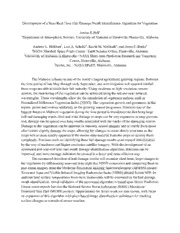
NASA Technical Reports Server (NTRS) 20150002897: Development of a Near-Real Time Hail Damage Swath Identification Algorithm for Vegetation PDF
Preview NASA Technical Reports Server (NTRS) 20150002897: Development of a Near-Real Time Hail Damage Swath Identification Algorithm for Vegetation
Development of a Near-Real Time Hail Damage Swath Identification Algorithm for Vegetation Jordan R Bell1 1Department of Atmospheric Science, University of Alabama in Huntsville, Huntsville, Alabama Andrew L. Molthan2, Lori A. Schultz3, Kevin M. McGrath4, and Jason E. Burks2 2NASA Marshall Space Flight Center / Earth Science Office, Huntsville, Alabama 3University of Alabama in Huntsville / NASA Short-term Prediction Research and Transition Center, Huntsville, Alabama 4Jacobs, Inc. / NASA SPoRT, Huntsville, Alabama The Midwest is home to one of the world’s largest agricultural growing regions. Between the time period of late May through early September, and with irrigation and seasonal rainfall these crops are able to reach their full maturity. Using moderate to high resolution remote sensors, the monitoring of the vegetation can be achieved using the red and near-infrared wavelengths. These wavelengths allow for the calculation of vegetation indices, such as Normalized Difference Vegetation Index (NDVI). The vegetation growth and greenness, in this region, grows and evolves uniformly as the growing season progresses. However one of the biggest threats to Midwest vegetation during the time period is thunderstorms that bring large hail and damaging winds. Hail and wind damage to crops can be very expensive to crop growers and, damage can be spread over long swaths associated with the tracks of the damaging storms. Damage to the vegetation can be apparent in remotely sensed imagery and is visible from space after storms slightly damage the crops, allowing for changes to occur slowly over time as the crops wilt or more readily apparent if the storms strip material from the crops or destroy them completely. Previous work on identifying these hail damage swaths used manual interpretation by the way of moderate and higher resolution satellite imagery. With the development of an automated and near-real time hail swath damage identification algorithm, detection can be improved, and more damage indicators be created in a faster and more efficient way. The automated detection of hail damage swaths will examine short-term, large changes in the vegetation by differencing near-real time eight day NDVI composites and comparing them to post storm imagery from the Moderate Resolution Imaging Spectroradiometer (MODIS) aboard Terra and Aqua and Visible Infrared Imaging Radiometer Suite (VIIRS) aboard Suomi NPP. In addition land surface temperatures from these instruments will be examined as for hail damage swath identification. Initial validation of the automated algorithm is based upon Storm Prediction Center storm reports but also the National Severe Storm Laboratory (NSSL) Maximum Estimated Size Hail (MESH) product. Opportunities for future work are also shown, with focus on expansion of this algorithm with pixel-based image classification techniques for tracking surface changes as a result of severe weather.
